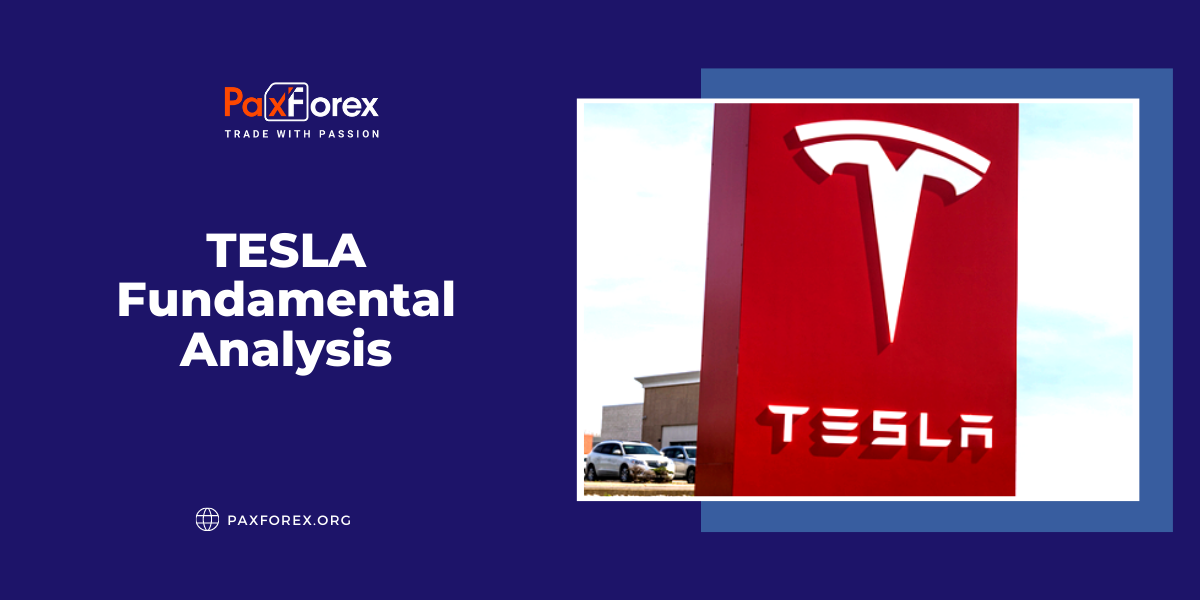
Source: PaxForex Premium Analytics Portal, Fundamental Insight
Elon Musk, the CEO of several prominent companies, including Tesla and SpaceX, is known for his entrepreneurial spirit and penchant for the limelight. His electric vehicle (EV) company, Tesla, is arguably his most notable brand, and his recent investor conference was highly anticipated by investors and Wall Street alike. Nevertheless, the event seemed to fall short of expectations, and Tesla's stock declined by nearly 13% over the following five trading days.
During the conference, Musk and his team revealed a 169-page deck detailing Tesla's future plans. The most significant takeaway from the presentation was Tesla's expected $10 trillion investment in manufacturing. Musk believes that Tesla is much more than just an automotive company and plans to push green energy further into the DNA of society by allocating capital to other forms of transportation and innovative features in manufacturing.
Yet, investors were underwhelmed by these revelations. Many were already aware of Tesla's focus on renewable energy and its goal to be the global leader in EV and green energy. While Musk's vision for the future was intriguing, investors were hoping for more information about new products, services, car designs, and so forth. The conference lacked the pizazz of past presentations and did little to inspire investors.
One positive development from the conference was Tesla's announcement of a new factory in Mexico. Regardless, given the company's proclaimed desire to be the global leader in EV and green energy, investors expected to hear more about Tesla's plans to build more factories worldwide.
Despite the lackluster investor conference, Tesla's valuation is still an arguable subject among Wall Street analysts and investors. Some investors, such as Ark Investment Management CEO Cathie Wood, are longtime Tesla bulls and have declared impossible price targets for the stock publicly. Others believe that Tesla is primarily an automobile manufacturer and does not earn the premium multiples the capital market assigns to it.
Two multiples worth analyzing are the price-to-earnings (P/E) ratio and the price/earnings-to-growth (PEG) ratio. Tesla's P/E ratio is currently nearly 54 times, which is significantly higher than the long-run average of the S&P 500 between 15 and 16 times P/E. Nevertheless, as of December last year, before the stock's run-up, its P/E was 38 times. The disparity between the P/E ratio at the end of December and its current value suggests that Tesla's current valuation may be inflated.
Tesla's PEG ratio is also higher than average at 1.8 times. A PEG ratio of 1.0 or lower may indicate that a stock is trading lower than its intrinsic value. Tesla's PEG ratio was 1.1 at the end of December 2022, indicating that the stock may have been undervalued at that time.
While Tesla's stock has been on a rollercoaster ride in recent months, there are several fundamental factors supporting its current valuation. The company's home charging initiative could create more recurring revenue, although not all current owners will approve of this plan. Likewise, TSLA will need to execute its future production targets for this initiative to affect Tesla's business significantly.
Toward the end of 2022, Tesla's stock began to decline, with many attributing this trend to cyclical trends in technology and software companies. This decline was driven by concerns about waning consumer demand stemming from lingering inflation and fears of recession. Despite these concerns, Tesla's Q4 2022 earnings were strong, and some investors saw a buying opportunity in early 2023 before Tesla posted its Q4 earnings. Several buyers joined the momentum, leading to a rise in Tesla's stock price. While the stock has experienced some sell-offs over the last month, it is only down roughly 11%, indicating that it may have some fundamental support.
If that is so, purchasing Tesla stock can be a compelling opportunity. However, investors with long-term goals should keep in mind that the duration of their investment matters more than attempting to time the market. Therefore, presently could be a reasonable moment to reduce your cost basis since the stock is experiencing a slight dip but still has a solid support base.
As long as the price is above 165.00, follow the recommendations below:
- Time frame: D1
- Recommendation: long position
- Entry point: 182.56
- Take Profit 1: 195.00
- Take Profit 2: 215.00
Alternative scenario:
If the level of 165.00 is broken-down, follow the recommendations below:
- Time frame: D1
- Recommendation: short position
- Entry point: 165.00
- Take Profit 1: 154.00
- Take Profit 2: 137.00













